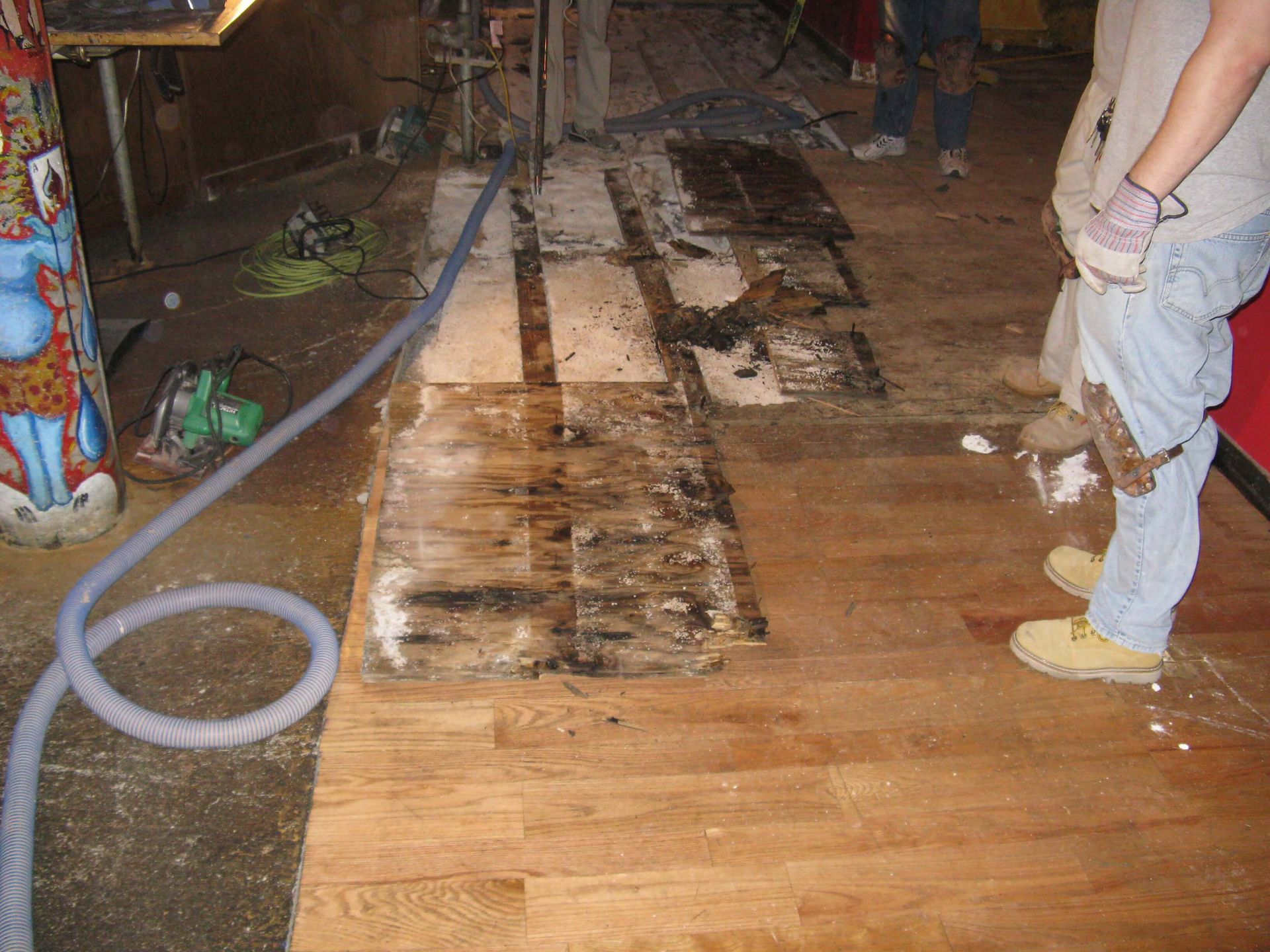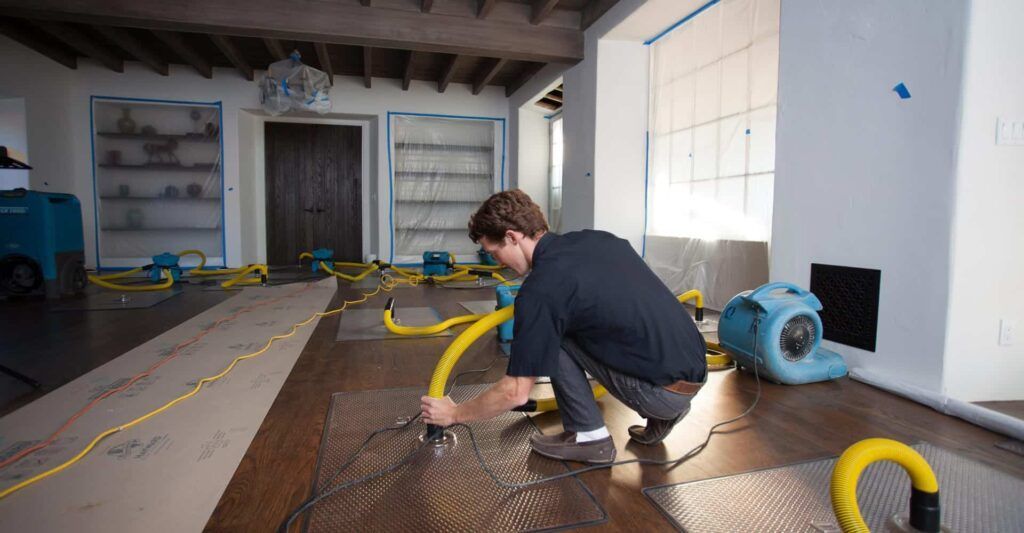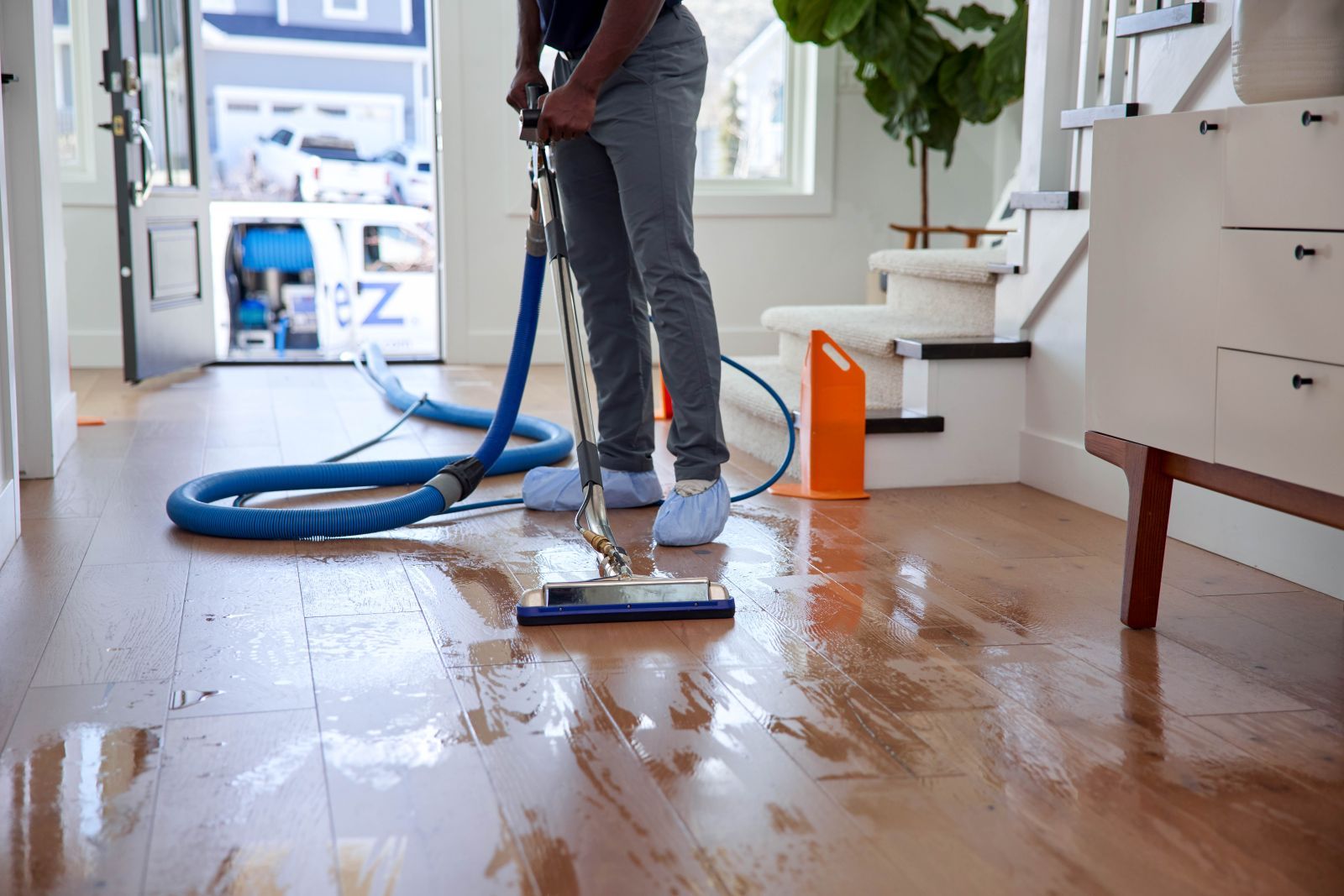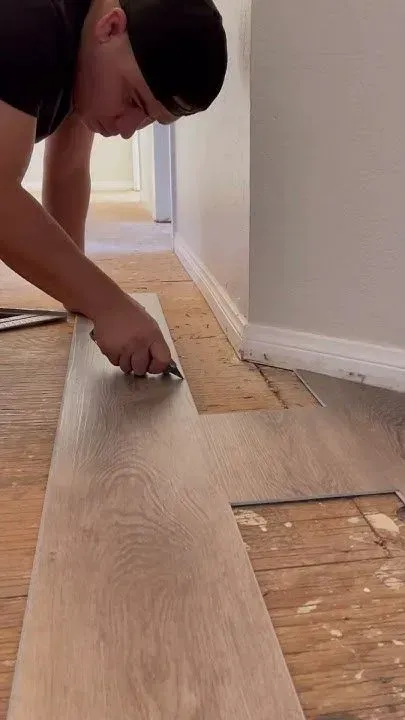Wood Floor Damage Restoration in Kansas City, MO
Water damage can wreak havoc on your beautiful hardwood floors, turning a proud home feature into a costly nightmare. At Kansas City Flooring Company, we understand the panic you feel when you discover water on your wood floors. Our 24/7 hardwood floor water damage restoration service can save your floors and prevent further damage if you act quickly.
We've been serving the Kansas City metro area for years, specializing in rescuing wood floors from water disasters large and small. Whether it's a minor leak or major flooding, our expert team arrives with professional equipment to extract water, thoroughly dry the affected areas, and assess the extent of the damage. Many homeowners don't realize that moisture can seep beneath the surface, causing warping, cupping, and even mold growth if not properly addressed.
Our restoration process involves more than just drying—we carefully evaluate if your floors can be saved through proper restoration techniques or if sections need replacement. Every water damage situation is unique, which is why we create customized solutions for each home we visit. You don't have to face water-damaged floors alone. Our team of wood flooring specialists has the expertise to bring your floors back to life, often saving you thousands compared to complete replacement costs.
Causes of Wood Floor Water Damage
Water damage to wood floors happens in several common ways. Plumbing leaks from dishwashers, refrigerators, and washing machines often cause severe damage because they can go unnoticed for days. Flooding from storms or rising water tables can quickly saturate floors. Even everyday spills from drinks or pet accidents can harm wood if they're frequent or left unattended.
Excessive humidity in your home can also damage wood floors over time. This is particularly common in basements or in humid climates like Kansas City. HVAC issues that create condensation near floors can slowly introduce moisture to your hardwood.
Roof leaks or window seals that fail during heavy rains might allow water to trickle down walls and eventually reach your flooring.
Types of Wood Floor Damage
Cupping occurs when water causes the edges of wood planks to raise higher than the center. This creates a concave appearance across the boards and is the first sign of moisture problems.
Crowning is the opposite of cupping. The center of boards rises higher than the edges when the top of the wood absorbs more moisture than the bottom.
Buckling is when the boards completely detach from the subfloor and can rise several inches. This happens in extreme flooding situations. Warping and swelling occur as wood fibers absorb water and expand. Once dried, these boards rarely return to their original shape without professional intervention. Staining and discoloration happen when water reacts with the wood's natural tannins or damages finishes and sealants.

Signs of Water Damaged Wood Floors
Discoloration is often the first noticeable sign. Look for dark spots, white water marks, or blackening at board edges or seams. These indicate moisture has penetrated the wood. Board separation happens as moisture causes wood to expand and contract. Gaps between planks that weren't there before suggest water damage.
Soft or spongy sections mean the wood's structural integrity is compromised. If your floor feels different when you walk on it, water damage may be the culprit. Musty odors often accompany water damage as mold begins to grow beneath or within the wood. If your room suddenly smells damp or earthy, check your floors.
Visible mold or mildew growth indicates significant moisture has been present for some time. This requires immediate attention to prevent health issues and further floor damage.
Steps for Water Damage Control

1. Moisture Detection and Mapping
We begin by using advanced moisture meters and thermal imaging cameras to identify all affected areas of your flooring. These tools help us see beyond what's visible to the naked eye, detecting moisture that may be hidden beneath the surface or in adjacent areas.
Our technicians create detailed moisture maps of your space, marking areas with different levels of water saturation. This scientific approach ensures we don't miss any damaged spots that could cause problems later.
The mapping process also helps us track progress during the drying phase. We'll take regular measurements throughout the restoration process to confirm your floors are returning to appropriate moisture levels.
This detailed analysis helps when dealing with insurance claims too. We provide comprehensive documentation of all damage found during our assessment.
2. Evaluating Subfloor and Structural Damage
Water doesn't just affect your visible hardwood flooring. It often penetrates to the subfloor and can compromise structural elements of your home.
Our technicians carefully inspect the subfloor by removing sections of damaged hardwood when necessary. We check for:
- Rotting or deterioration of plywood subfloors
- Weakened joists or support beams
- Signs of mold or mildew growth
- Warping or buckling that affects structural integrity
We evaluate whether your subfloor needs simple drying or complete replacement. This assessment is critical because structural issues left unaddressed can lead to sagging floors, squeaky boards, and even safety hazards down the road.
We also inspect surrounding areas like walls and baseboards that might have absorbed water and require additional attention.
3. Subfloor and Floorboard Repairs
e start by removing damaged floorboards to access and evaluate the subfloor condition. Many homeowners don't realize that a wet subfloor can continue causing problems even after surface water is gone.
For minor damage, we can often save portions of your existing floor through targeted repairs. We'll replace only the damaged boards, matching the wood type and grain pattern as closely as possible to your original flooring.
In cases of severe water damage, a complete replacement of affected sections may be necessary. Our team carefully removes the damaged areas and installs new materials that blend seamlessly with your existing floor.
We use moisture meters to ensure the subfloor is completely dry before installing new hardwood, preventing future warping or mold growth.
4. Sanding and Refinishing Techniques
Once structural repairs are complete, we restore your floor's appearance through professional sanding and refinishing. Our process begins with careful sanding to remove water stains, discoloration, and old finish.
We use a three-step sanding process:
- Coarse sanding - Removes major damage and old finish
- Medium sanding - Smooths the surface and prepares for final sanding
- Fine sanding - Creates the perfect surface for new stain and finish
After sanding, we apply stain that matches your existing floor or creates your desired new look. We offer various finish options including:
- Oil-based polyurethane (durable, amber tone)
- Water-based polyurethane (clear, fast-drying)
- Hardwax oil (natural look, easy to repair)
5. Mold Prevention and Remediation
Water-damaged floors often develop mold growth, which poses health risks to your family. We take mold seriously and address it thoroughly during our restoration process.
Our team conducts thorough testing to identify existing mold problems. For affected areas, we use specialized antimicrobial treatments that eliminate mold at its source, not just surface growth.
Prevention is just as important as remediation. We apply protective treatments that discourage future mold growth while maintaining your floor's natural beauty.
Key prevention steps include:
- Proper ventilation during and after restoration
- Moisture barrier installation where needed
- Humidity control recommendations
- Specialized sealants for high-risk areas
6. Addressing Hidden Water Damage
Water has a way of finding hidden paths through your home's structure. Our extensive experience allows us to identify and address damage that might otherwise go unnoticed.
We inspect wall bases, trim, and adjacent areas that might have absorbed moisture. Sometimes, water travels along joists or through wall cavities, causing damage far from the original source.
Thermal imaging equipment helps us detect hidden moisture pockets that aren't visible to the naked eye. This technology allows us to be precise in our repairs, addressing all affected areas without unnecessary work.
We also check for signs of structural weakening. Water can compromise the integrity of supporting structures, creating safety hazards that require immediate attention.
7. Regular Floor Maintenance and Inspection
Inspect your hardwood floors monthly for signs of water damage like discoloration, buckling, or warping. Pay special attention to areas around sinks, toilets, showers, and exterior doors.
Use only manufacturer-recommended cleaning products. Harsh chemicals can damage the finish, making your floors more vulnerable to moisture penetration. We recommend:
- Sweeping or dust-mopping daily
- Damp-mopping weekly with a nearly-dry mop
- Professionally cleaning every 6-12 months
Check the condition of your floor's finish annually. A proper seal is crucial for keeping moisture out. If you notice the finish wearing thin, contact us for refinishing before water damage occurs.

Understanding Insurance Coverage for Water Damage
Most homeowner insurance policies cover sudden and accidental water damage, but coverage details vary significantly between policies. Typically, burst pipes, overflowing appliances, and storm damage are covered, while gradual leaks or flooding may require separate policies.
We recommend reviewing your policy carefully to understand:
- Replacement Cost - Replacement cost provides better coverage as it doesn't deduct for depreciation
- Coverage Limits - Many policies have caps on water damage claims
- Exclusions - Common exclusions include neglect, poor maintenance, or flood damage
Our team help explain what aspects of your wood floor restoration might be covered based on our experience with various insurance providers in Kansas City.

Documentation and Claims Process
Proper documentation is crucial for successful insurance claims. We recommend taking these steps immediately after discovering water damage:
- Take clear photos and videos of all damaged areas
- Keep samples of damaged flooring when possible
- Document all communication with your insurance company
We provide detailed damage assessments. This includes moisture readings and scope of damage reports. Our estimates clearly outline necessary repairs and replacements with itemized costs.
When you work with Kansas City Flooring Company, we create professional documentation that insurance companies recognize and respect. This thorough approach often leads to more successful claims.
Aftercare and Long-Term Preservation
Restoring your water-damaged floors is just the beginning of your hardwood's renewed life. Proper aftercare ensures your investment lasts for decades to come.
Post-Restoration Floor Care Tips
After we've completed the restoration of your water-damaged hardwood floors, maintaining their beauty requires simple but consistent care. Sweep or dust mop your floors daily to prevent scratches from dirt and debris. Use only manufacturer-recommended cleaning products—never steam cleaners or wet mops that can reintroduce moisture.
Place felt pads under furniture legs and use protective mats in high-traffic areas. Maintain indoor humidity between 35-55% year-round to prevent wood expansion and contraction.
Wipe up spills immediately to prevent future water damage. We recommend using microfiber mops for regular cleaning as they effectively capture dust without scratching your floors.
Scheduling Professional Maintenance Services
Regular professional maintenance is key to extending the life of your restored hardwood floors. We recommend scheduling professional inspections every 12-18 months to catch potential issues before they become costly problems.
Our maintenance services include dryness testing using moisture meters to ensure your floor remains at optimal moisture content. This is particularly important in the first year after water damage restoration.
Professional screening and recoating every 3-5 years adds a fresh layer of protection without the cost of full refinishing. This process removes minor scratches and refreshes the protective coating.
For floors that have experienced water damage, we offer specialized check-ups in the months following restoration to monitor for any delayed effects or settling issues.
Ensuring Long-Term Durability and Aesthetics
Long-term preservation of your hardwood floors begins with prevention. Install water detection devices near appliances that could leak. Consider waterproof mats in areas prone to spills like entryways and kitchens.
We recommend professional deep cleaning annually to remove embedded dirt from grain patterns and refresh your floor's appearance. This includes careful attention to expansion joints and edges where moisture can hide.
UV protection is essential for preventing fading and discoloration, especially for floors near windows. Apply window treatments or UV-resistant films to prevent sun damage.
Still have a question?
Call us now at (816) 555-0123 or fill out our simple contact form on our website. We'll respond within 24 hours to discuss your specific requirements.
